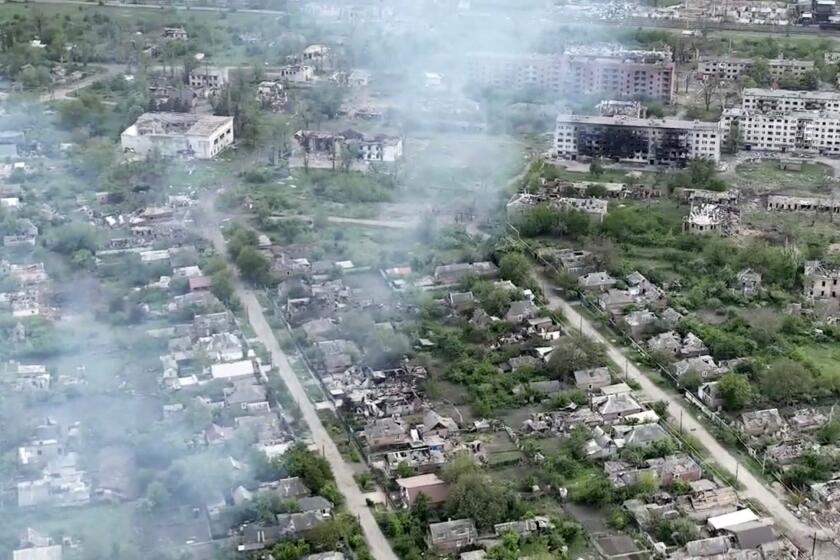With Rotation, Troops in Iraq to Get Grayer
The last time the Marine Corps sent Ted Hogan into a war zone, Lyndon B. Johnson was president and there was no such thing as a Super Bowl.
Hogan was 18 and fresh out of high school in rural Iowa when he was shipped to Vietnam in 1966. He spent two years there and was awarded the Purple Heart after being wounded in a mortar attack.
Now, two weeks shy of his 56th birthday and recently retired from a three-decade career as a tractor-factory machinist, Hogan is preparing to go to Iraq in the next few weeks as a master gunnery sergeant in the Marine Corps Reserves.
“I have mixed emotions about it,” Hogan said during rifle range training to brush up on the M-16 and the machine gun. “I’ve been there [in a war zone] before. I just hope I can help the junior Marines know what to expect and how to get through it.”
Call it the graying of the fighting force.
As the U.S. military begins a massive rotation of troops in Iraq, the increasing reliance on reservists and National Guard troops means that units being sent as replacements will have a much higher percentage of personnel older than 40.
The face of America being shown to the Iraqis will have more lines in it than ever before. But officials believe it will also have greater maturity and patience, advantages both in relating to the Iraqis and providing leadership to much younger U.S. troops.
Hogan and other reservists from Rock Island, Ill., are part of the 1st Force Service Support Group, which has the vital, if unglamorous, job of ensuring that the vehicles, equipment, weaponry and other supplies needed by 20,000 troops of the 1st Marine Division going to Iraq are safely transported and then adequately maintained.
With attacks on U.S. convoys an almost daily occurrence in Iraq, it is a job that looms as difficult and dangerous.
Hogan’s wife, Linda, said she is receiving calls from the mothers of young reservists asking her to ask her husband to look after their sons when the battalion goes to Iraq.
“The mothers are worried,” she said in a telephone interview from the Hogans’ home in Holy Cross, Iowa, set in an 80-acre cornfield. “I try to tell them it’s going to be fine.”
Once the upcoming rotation is complete -- probably by late April -- the proportion of reservists and Guard troops among the overall U.S. force in Iraq will have more than doubled, according to Pentagon figures.
Among active-duty enlisted troops in the Army, 6% are 40 or older. But in the Army Reserve, the figure is 21% and in the National Guard, it is 22%.
Among enlisted Marines, the percentage that are 40 or older is roughly 3% in both the active-duty and reserve force. Among officers, however, 17% of those on active duty are 40 and older, and among reserves, it is 44%.
Also, the kind of Marine reserve units being activated -- support, military police, intelligence, civil affairs -- tend to have greater number of older Marines than units where physical stamina is more important: infantry, artillery and armor.
Reserve Lt. Col. Geff Cooper, 51, a sheriff’s deputy for San Bernardino County, has assembled a squad of eight reservist cops -- “every one of them over 35” -- to assume responsibility for training Iraqi civilian police in the volatile zone west of Baghdad.
“You get older and hopefully you get wiser and patient,” Cooper said. “I know when I was young I was very impatient with people. This is not a kick-butt combat mission. This is a security and stability mission. Maturity should help.”
The older reservists will have a lot of younger Marines to mentor. More than 70% of the Marine reserve force is 25 or younger.
“We have a young force; it’s a definite asset to have someone who’s been through things before,” said Capt. Jeff Pool, an official at Marine reserve headquarters in New Orleans.
The average reservist call-up is for a year, with the possibility of an additional year. The assignment in Iraq is set to last seven months.
While other reservists are having their college years disrupted, for Ted and Linda Hogan, the call-up means delaying their retirement plans, which were to include fishing trips in Minnesota and time with their grandson.
Hogan was activated within days of his retirement from the Deere & Co. farm-equipment plant in Dubuque.
The couple married in 1971 after corresponding while Ted was in Vietnam. He left active duty in 1972 but joined the reserves in 1982.
Hogan’s reserve unit narrowly missed being called for duty in the Persian Gulf War in 1991. He did a four-month active-duty stint in Alaska last year.
Hogan has stayed fit through a regimen of running and weight-lifting. He can do 18 “dead-hang” pull-ups without breaking a sweat.
Still, the uncertainty of the future has Linda Hogan and the couple’s three grown daughters apprehensive.
“It’s hard to go through this,” she said. “This was supposed to be ‘our’ time together. But he’s a Marine, he’s always been a Marine, and I would never take that away from him.”
Hogan turns aside questions about whether Marines in the 1960s were different from those of today.
“We were Marines then, we’re Marines now,” he said.
But he has noted one difference between Vietnam and the mission in Iraq: public reaction to service personnel.
“When we got back from Vietnam, we were treated like road kill that didn’t die,” he said. “Now the soldiers, Marines and sailors get respect. I like that better.”
More to Read
Start your day right
Sign up for Essential California for news, features and recommendations from the L.A. Times and beyond in your inbox six days a week.
You may occasionally receive promotional content from the Los Angeles Times.





